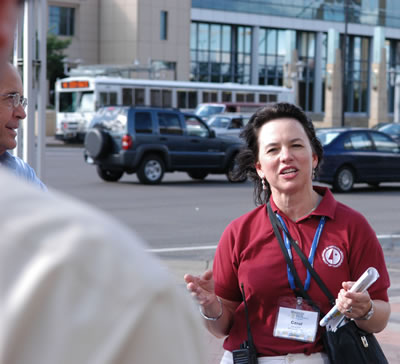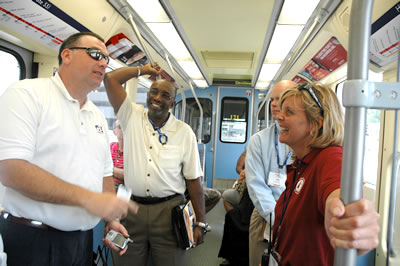By Craig Wilkins

Carol Zoff, landscape architect senior in the Office of Environmental Services, leads a group of Mississippi Valley Conference participants in a walking tour of downtown Minneapolis. Photo by Colleen Anfang |
Participants in this year’s Mississippi Valley Conference in Minneapolis rode bikes, took light rail transit and walked historic areas of the city in addition to attending the usual rounds of workshops and committee meetings. The conference was held July 9-11.
Tours included visits to the Minnesota Road Research Program facility near Albertville, the Hiawatha light rail transit control center and maintenance facility in Minneapolis and the Regional Transportation Management Center in Roseville.
The 2007 meeting was the first time that the American Association of State Transportation Officials’ regional conference met outside Chicago since 1909.
More than 400 people attended including representatives from cities, counties, state DOTs as well as contractors and consultants from the private sector.
Major speakers included Mary Peters, Secretary of Transportation; U.S. Rep. James Oberstar, Minn., chair of the House Transportation Committee, and Lt. Gov./Commissioner Carol Molnau.
“The theme of this year’s conference is ‘People, Partners and Programs,’ which is fitting because we have many partners here who have joined in the fight against congestion that threatens to choke our cities and our economy,” Molnau said in her remarks to open the meeting.
The conference focused on issues including safety, mobility, freight movement and partnerships.
Rick Kjonaas, deputy State Aid to Local Transportation engineer, said the panel on partnerships enabled participants to share successes, explore challenges and consider new options.
Kjonaas noted panelist Lou Tasa, District 2 state aid engineer, who reported on the district’s collaboration with three counties Minnesota to build a 10-ton highway to provide year-round truck access to cities such as Roseau and Warroad in northern Minnesota.

Jodi Thurner, Hiawatha LRT Project Office, joins conference participants on the Hiawatha LRT en route to tour the rail system’s control center and maintenance facility in Minneapolis. Photo by Craig Wilkins |
When completed this fall, the 37-mile network of improved county roads will provide year-round heavy truck route that will extend from Grygla to Gully.
The panels and other sessions, Kjonaas said, created lively exchanges among participants anxious to find new ways to alleviate congestion and other traffic-related problems.
During another panel on congestion management, Mn/DOT’s Brian Kary shared some of the steps the agency has taken to reduce traffic congestion in Minnesota.
Kary, operations engineer with Freeway Management Systems, cited the department’s use of “small fixes” to alleviate congestion. Those measures include adding a third lane to part of Hwy 100 in the Twin Cities until major reconstruction occurs and building auxiliary freeway ramps to improve traffic flow.
Kary said he was encouraged to learn of similar efforts by other states.
“Texas, other states and some cities are experiencing the same results as our projects,” he said. “That helps build the case for us and other states to use innovative, limited-scale efforts to address major congestion issues.”
At the meeting’s close, Molnau said the conference provided a valuable forum to address current and future transportation issues.
“The challenge for us as individual states is to go back and apply what we have learned to our own unique challenges at home,” she said. “The challenge for all of us as partners is to continue to work together to provide the best transportation system possible for American citizens.”
|



